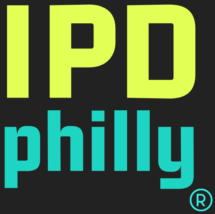Celebrates the Work of Brujo de la Mancha
By Ashley Caranto Morford
Featured Image: Brujo de la Mancha with Campatlanezi at the IPDphilly 2021 | Photo by David Tavani
The territory widely known as Philadelphia is part of Lenapehoking — the sovereign and unsurrendered homelands of the Lenape Peoples. Therefore, Philadelphia is — following the words of Cree-Métis educator, community planner, and filmmaker Kamala Todd (2015) — “an Indigenous city,” just as every city in the so-called Americas is (Todd par. 17). While the settler government in Philadelphia officially recognized October 11, 2021, as Indigenous Peoples’ Day, every single day on this land is Indigenous Peoples’ Day. This always has been and always will be sovereign and unsurrendered Indigenous territory.
“Philadelphia is Indigenous Land: Celebrating the Rich and Ongoing History of Indigenous Peoples’ Day in the City” is a series that recognizes, celebrates, and shares the stories of some of the wonderful Indigenous people living in the area who have played a vital role in fighting for, organizing, and amplifying Indigenous Peoples’ Day commemorations in the city. Pasasalamat, gratitude, and thanks, to the Indigenous organizers who have shared their stories, truths, knowledges, and experiences as part of this multi-part series.
One Indigenous organizer who has played a central role in fostering Indigenous Peoples’ Day celebrations in the city is Brujo de la Mancha (Tlaxcalan/Mexican-Indigenous and Spanish). His Native name is Tlexayacoatl, meaning the Snake with the Face on Fire. De la Mancha emphasizes that holding space to proudly celebrate Indigenous Peoples during a time when the settler population has historically celebrated Columbus’ violent legacies serves as a powerful declaration that Indigenous Peoples are still alive despite Columbus.
De la Mancha is a cultural educator, community organizer, and multidisciplinary artist who has always been involved in working for Indigenous rights and cultures, and has dedicated his life to honoring his culture and where he came from. De la Mancha grew up in Mexico City but has lived in Lenapehoking since February 1998. When he first arrived, not many people were talking about Indigenous Peoples or Indigenous Peoples’ Day.
As a Tlaxcalan organizer and educator, he notes that there was a particular absence of conversation about the diversity of Indigenous Peoples and cultures in the territories colonially called Central and Latin America, even as many Indigenous people whose homelands are in those parts of the Americas currently live in the city. For over a decade, de la Mancha has been working to create and support celebrations within Lenapehoking for all Indigenous Peoples from all Indigenous nations, all of whom have been and continue to be impacted by colonialism.
De la Mancha points to Vaughnda Hilton (Seminole Creek-Blackfeet) and the late Pocahontas Turquoise Sunrise Barbara Allen (Seminole/Creek/Cherokee) as two key figures in the founding of the city’s Indigenous Peoples’ Day celebrations. When he met them, they were organizing powwows for the local Indigenous community. Vaughnda and Pocahontas understood and supported his vision of an Indigenous Peoples’ Day celebration where a diversity of Native peoples could come together and celebrate their belonging to this continent. Together, they organized, fought for, and established the celebrations, which are now in their 11th year. De la Mancha stresses the importance of belonging. For some Indigenous people, the creation of borders and United States immigration laws treat them like they don’t belong here or are not from this continent. Just as the Indigenous peoples whose territories are occupied by the United States and Canada have experienced the traumas of colonization, many of the people known as undocumented immigrants are Indigenous to this continent but cannot move freely on these lands and suffer the prejudices of being called “illegal immigrants.”
In the early 2000s, de la Mancha started organizing with Mexican Indigenous communities around the city. In 2003, alongside Daniel Chico Lorenzo (Mexican-Indigenous of Ozolco Puebla), de la Mancha founded Ollin Yoliztli Calmecac (OYC), an educational organization centering Mexicayotl traditions and teachings and the first Aztec dance troupe in the city. In 2004, the organization organized its first gathering in commemoration of the final battle that the Aztecs fought to defend Tenochtitlan. OYC created the first Philadelphia Indigenous Peoples’ Day and, eleven years later, we see how this seed has spread and is bearing fruits. So many others have helped Ollin Yoliztli Calmecac. Without the support of board members, volunteers, and funders like the Pennsylvania Council of the Arts, people like Charon Battles (former Director of The Preserving Diverse Cultures Division), and, of course, the dancers throughout OYC’s history, this work could not be done.
As de la Mancha emphasizes, settler Philadelphia is only just waking up to issues of colonization, settler colonialism, and Indigenous rights, but Indigenous people have been doing this work for a long time. Moving forward, de la Mancha hopes to see the establishment of a center for Indigenous Peoples of the continent and organizing within the city, an official and collective space and place where new generations of Indigenous people could go to learn and be supported.
Deepest pasasalamat, gratitude, and thanks, to Brujo de la Mancha for sharing his stories, truths, knowledge, and experiences as part of this multi-part series, “Philadelphia is Indigenous Land: Celebrating the Rich and Ongoing History of Indigenous Peoples’ Day in the City”.
If you would like to donate to Brujo’s organization Ollin Yoliztli Calmecac (OYC) – Click Here!



AUTHOR: Ashley Caranto Morford (Filipina-English descent / Canadian-USA) – Associate Writer


